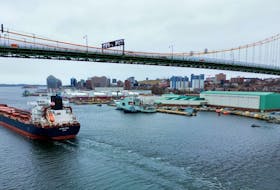The master’s graduate student in science from the Centre for Sustainable Aquatic Resources, Marine Institute of Memorial University, was guest speaker for the weekly Coastal Matters series at Grenfell Campus, Memorial University in Corner Brook Thursday.
His presentation discussed promoting the conservation of Atlantic cod through the improvement and implementation of cod pots in the province.
Here are five things to know about cod pots.
1. What they are:
Pots are stationary, baited traps used to capture fish live. There are two types — heavy Newfoundland pots, and lighter, collapsible Norwegian pots.
2. The issue:
Traditionally, cod fishing has been done in Newfoundland and Labrador using trawls and gillnets. The former destroys habitats on the sea floor, while the latter produces high rates of bycatch, other than the targeted codfish. In both methods, the fish are often dead when harvested or potentially damaged by the elements before plucked from the sea.
3. The benefits of using cod pots
Pots produce lower bycatch and less habitat destruction than other forms of nets, and may be suitable as an alternative fishing gear for use in Newfoundland and Labrador. Pots also allow the fish to be caught live, which would mean a higher-quality product that could fetch a better price on the market.
4. The research
Meintzer was involved in research aimed at determining whether the Newfoundland or Norwegian pots worked better. Conducted off Fogo and the coast of Labrador, the research showed that, while the Norwegian pot caught more fish than the Newfoundland version, a modified version of the Newfoundland pot seemed to work the best.
5. Where to from here?
The cod trap could prove to be an effective fishing tool for some harvesters, but it has yet to catch on as the predominant method of catching cod in Newfoundland and Labrador.
Meintzer said there is still plenty of room for innovation and further modifications of the traps to make them work even better.
Twitter: WS_GaryKean
The master’s graduate student in science from the Centre for Sustainable Aquatic Resources, Marine Institute of Memorial University, was guest speaker for the weekly Coastal Matters series at Grenfell Campus, Memorial University in Corner Brook Thursday.
His presentation discussed promoting the conservation of Atlantic cod through the improvement and implementation of cod pots in the province.
Here are five things to know about cod pots.
1. What they are:
Pots are stationary, baited traps used to capture fish live. There are two types — heavy Newfoundland pots, and lighter, collapsible Norwegian pots.
2. The issue:
Traditionally, cod fishing has been done in Newfoundland and Labrador using trawls and gillnets. The former destroys habitats on the sea floor, while the latter produces high rates of bycatch, other than the targeted codfish. In both methods, the fish are often dead when harvested or potentially damaged by the elements before plucked from the sea.
3. The benefits of using cod pots
Pots produce lower bycatch and less habitat destruction than other forms of nets, and may be suitable as an alternative fishing gear for use in Newfoundland and Labrador. Pots also allow the fish to be caught live, which would mean a higher-quality product that could fetch a better price on the market.
4. The research
Meintzer was involved in research aimed at determining whether the Newfoundland or Norwegian pots worked better. Conducted off Fogo and the coast of Labrador, the research showed that, while the Norwegian pot caught more fish than the Newfoundland version, a modified version of the Newfoundland pot seemed to work the best.
5. Where to from here?
The cod trap could prove to be an effective fishing tool for some harvesters, but it has yet to catch on as the predominant method of catching cod in Newfoundland and Labrador.
Meintzer said there is still plenty of room for innovation and further modifications of the traps to make them work even better.
Twitter: WS_GaryKean









